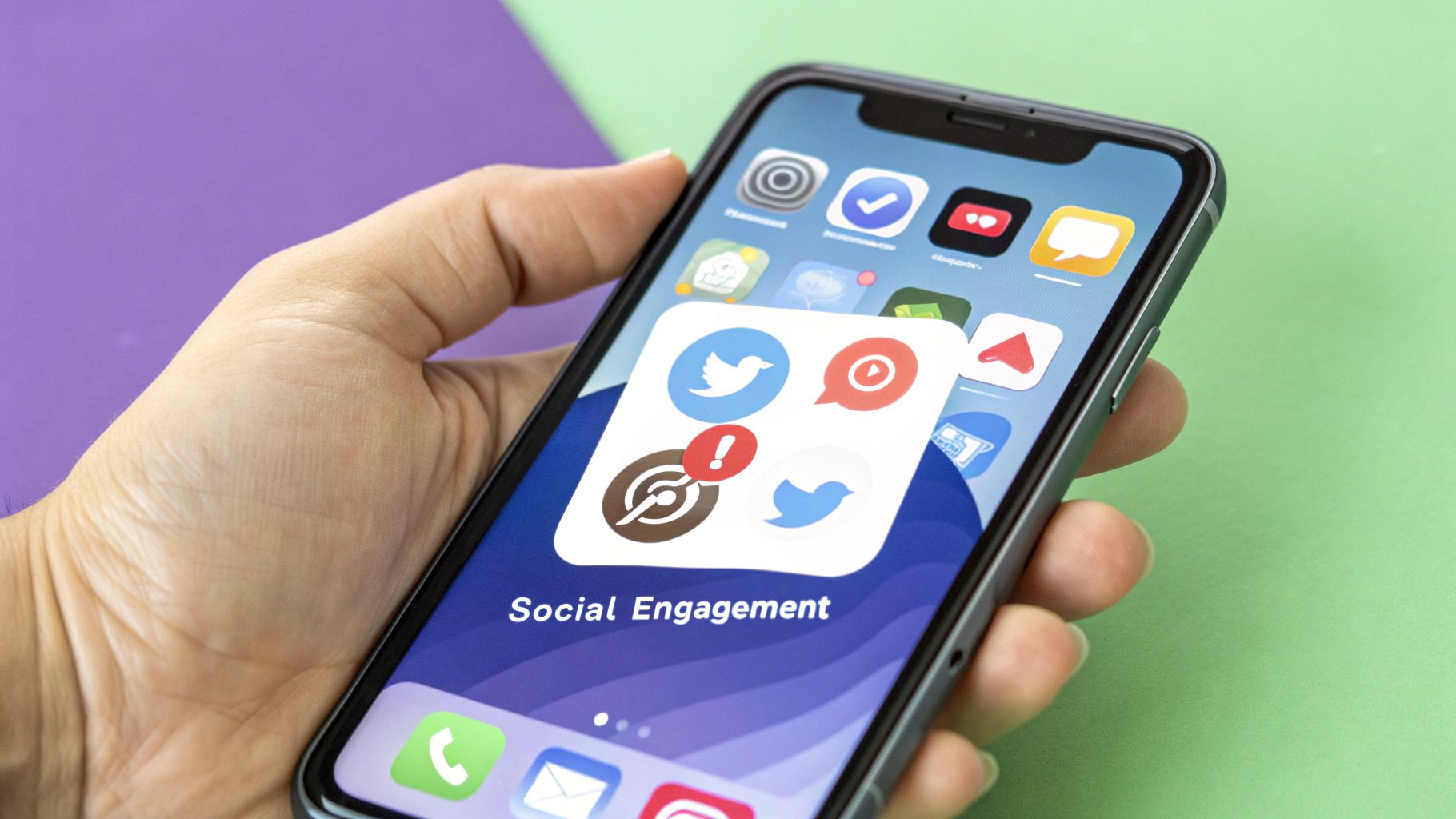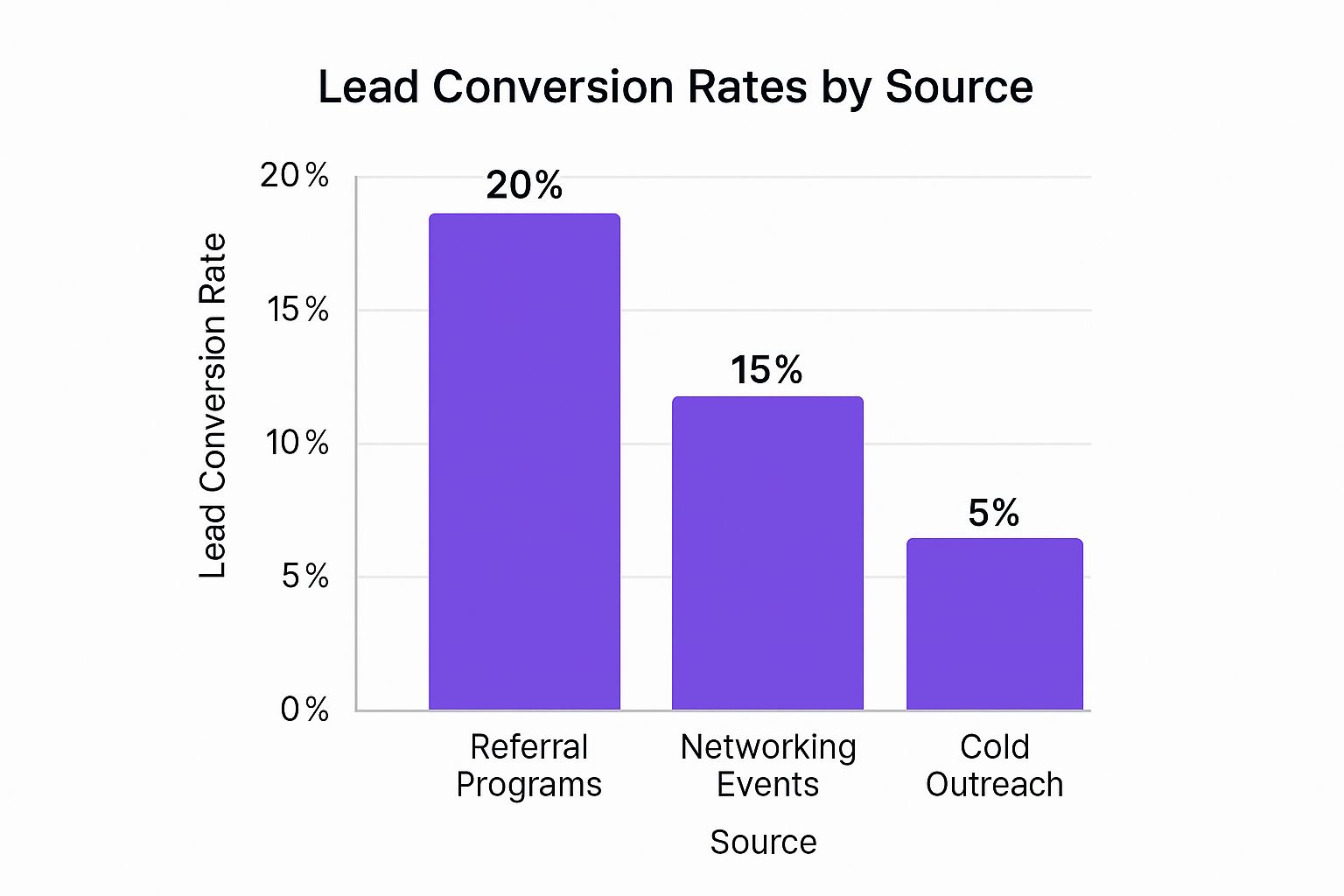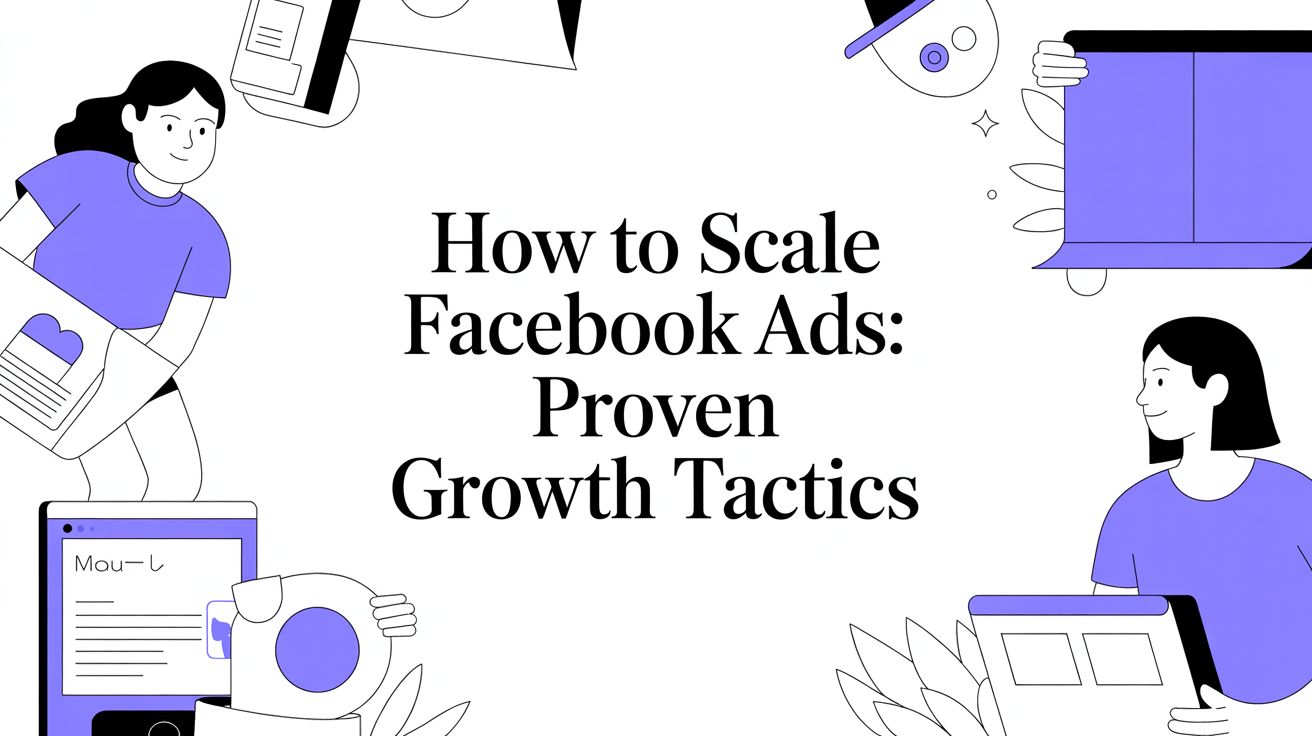Finding new customers is the lifeblood of any small business, but it's often the most significant challenge. Effective small business lead generation isn't about casting a wide, expensive net and hoping for the best; it's about building a predictable system that consistently attracts and converts your ideal customers. Without a steady stream of qualified leads, growth stalls, revenue becomes unpredictable, and your business is left vulnerable.
This guide cuts through the noise. We're skipping the vague theories and diving straight into actionable strategies tailored for small businesses. You'll get a clear roadmap for implementing proven tactics that turn prospects into paying customers. This isn't just a list; it's a playbook designed to build a reliable engine for sustainable growth.
From mastering local SEO to creating compelling email campaigns, we will cover eight powerful methods complete with implementation tips and real-world examples. Whether you're a local service provider, a B2B consultant, or an e-commerce startup, these strategies will equip you with the tools needed to build a pipeline that fuels your business for years to come. Let's get started.
1. Content Marketing & SEO
Content marketing is the engine of modern small business lead generation. Instead of directly pitching your products or services, you create and distribute valuable, relevant, and consistent content to attract and retain a clearly defined audience. When combined with Search Engine Optimization (SEO), this content becomes a powerful magnet, drawing in potential customers who are actively searching for solutions you provide.

The goal is to answer your audience's questions and solve their problems. Think of how HubSpot offers comprehensive marketing blogs and free tools to attract business owners, or how a local plumber ranks for "emergency plumber near me" by creating helpful articles about preventing pipe bursts. This approach builds trust and establishes your authority long before a customer is ready to buy.
How to Implement This Strategy
- Focus on Niche Keywords: Target long-tail keywords (phrases of three or more words) that show commercial intent, such as "best accounting software for freelancers" instead of just "accounting software." These searches often come from users closer to making a purchase.
- Create Content Clusters: Build your content around core "pillar" topics central to your business. Create one comprehensive pillar page and surround it with smaller, related "cluster" blog posts that link back to it. This structure signals your expertise to search engines.
- Use Lead Magnets: Offer a valuable, free resource like an ebook, checklist, or webinar in exchange for a visitor's email address. This converts passive readers into active leads. For a detailed exploration of how content can drive leads, refer to this ultimate guide to content marketing for small businesses.
Key Metrics to Track
To measure success, monitor your organic traffic, keyword rankings for your target terms, and the conversion rate of your lead magnets. This data will tell you what's working and where to focus your efforts. As a fundamental part of any digital marketing for startups, mastering content and SEO is non-negotiable for sustainable growth.
2. Social Media Marketing
Social media is no longer just for brand awareness; it's a dynamic channel for small business lead generation. This strategy involves leveraging platforms where your target audience spends their time to build relationships, share valuable content, and guide potential customers directly into your sales funnel. By combining organic engagement with targeted paid advertising, you can turn followers into leads.

The key is to meet customers where they are and engage them with content that feels native to the platform. Consider a local restaurant using mouth-watering Instagram stories to promote a new dish and drive reservations, or a B2B consultant sharing industry insights on LinkedIn to connect with potential clients. This approach fosters community and trust, making the sales process feel more natural.
How to Implement This Strategy
- Choose Platforms Wisely: Don't stretch yourself thin. Focus on the 2-3 platforms where your ideal customer is most active. A visual brand might thrive on Instagram and Pinterest, while a service-based business may find more success on LinkedIn or Facebook.
- Use Lead Generation Ads: Platforms like Facebook and LinkedIn offer specific lead ad formats. These ads feature a pre-filled form with the user's profile information, making it incredibly easy for them to submit their details without ever leaving the app.
- Engage Authentically: Go beyond just posting. Respond to comments, answer direct messages promptly, and participate in relevant conversations. Authentic engagement builds strong relationships and shows potential leads there's a real person behind the brand. For deeper insight, you can explore this guide on how the social media algorithm works.
Key Metrics to Track
To gauge the effectiveness of your social media efforts, focus on your click-through rate (CTR) on lead-generating posts, the cost per lead (CPL) from your paid campaigns, and the conversion rate of leads generated from social channels. These metrics provide a clear picture of your ROI and help you refine your strategy over time.
3. Email Marketing Campaigns
Email marketing is a cornerstone of effective small business lead generation, offering a direct and personal line of communication with potential and existing customers. It involves sending targeted messages to nurture leads, promote products, and build lasting relationships. Unlike social media, where algorithms dictate reach, email provides a reliable way to land your message directly in a prospect's inbox.
The strategy works by converting website visitors or social media followers into subscribers and then nurturing them through the sales funnel with valuable content. Think of an e-commerce store sending abandoned cart reminders to recover lost sales, or a consultant distributing a weekly newsletter with industry insights to stay top-of-mind. This consistent contact builds trust and guides leads toward a purchasing decision.
How to Implement This Strategy
- Segment Your Audience: Don't send the same email to everyone. Group your subscribers based on their behavior, interests, or purchase history. A new subscriber should receive a welcome sequence, while a loyal customer might get exclusive offers.
- Write Compelling Subject Lines: Your subject line is the gatekeeper to your message. Keep it short, intriguing, and personalized to maximize open rates. A/B test different versions to see what resonates with your audience.
- Provide Value and a Clear CTA: Every email should offer something valuable, whether it's a helpful tip, a discount, or exclusive content. Crucially, include a single, clear call-to-action (CTA) that tells the reader exactly what to do next, like "Shop Now" or "Read the Blog Post."
Key Metrics to Track
To gauge the effectiveness of your campaigns, monitor your open rate, click-through rate (CTR), and conversion rate. These metrics will reveal how engaging your content is and whether it's successfully driving action. For small businesses looking to scale their outreach without increasing manual effort, diving deeper into a guide to automated email marketing campaigns is an excellent next step. For a complete overview of structuring your outreach, consider reviewing a marketing campaign planning template.
4. Networking and Referral Programs
Sometimes the most effective small business lead generation strategies are built on human connection. Networking and referral programs leverage your existing relationships with customers, partners, and professional contacts, turning them into a powerful, word-of-mouth marketing force. This approach relies on trust, as a recommendation from a known source is often more persuasive than traditional advertising.

Think of how Dropbox grew exponentially by offering extra storage space to users who referred friends, or how local accountants find their best clients through chamber of commerce events. These leads are often highly qualified and more likely to convert because they come with pre-established credibility. The bar chart above clearly visualizes the superior conversion rates from referral programs and networking compared to cold outreach. This data underscores why investing in relationships can yield a significantly higher return.
How to Implement This Strategy
- Create a Systematic Referral Program: Don't just hope for referrals; build a structured program. Define clear rewards (e.g., discounts, cash, gift cards) and make it incredibly easy for customers to participate with a unique link or code.
- Join Niche Networking Groups: Instead of general business groups, seek out industry-specific associations or communities like BNI (Business Network International). This puts you in a room with potential partners and clients who already understand your value proposition.
- Focus on Giving First: The core of successful networking is providing value before you ask for anything in return. Offer advice, make introductions, and share resources. This builds goodwill and makes people eager to help you when you need it.
Key Metrics to Track
Measure your success by monitoring the number of qualified referrals received, the lead-to-customer conversion rate from referred leads, and the Customer Acquisition Cost (CAC) for this channel. High conversion rates and a low CAC will prove the immense value of your network.
5. Paid Advertising (PPC)
While strategies like SEO build momentum over time, paid advertising, or Pay-Per-Click (PPC), offers an immediate way to drive targeted traffic and leads. This approach involves paying platforms like Google, Facebook, or LinkedIn to place your ads in front of a highly specific audience. It's a direct and powerful method for small business lead generation because you only pay when someone takes a desired action, like clicking your ad.
The primary advantage is speed and precision. A local plumber can bid on "emergency plumbing services" on Google Ads and appear instantly to someone with a burst pipe. Similarly, a B2B software company can use LinkedIn Ads to target marketing managers at companies of a specific size. This level of control makes PPC an invaluable tool for capturing high-intent leads exactly when they are looking for a solution.
How to Implement This Strategy
- Start Small and Scale: Begin with a modest daily budget to test your campaigns. Once you identify which ads, keywords, and audiences deliver a positive return on investment, you can confidently scale up your spending.
- Create Dedicated Landing Pages: Never send paid traffic to your generic homepage. Instead, direct users to a dedicated landing page designed specifically for the ad campaign. This page should have a clear call-to-action and remove any distractions, maximizing conversion rates.
- Focus on High-Intent Keywords and Audiences: In Google Ads, target long-tail keywords that signal a user is ready to buy (e.g., "hire a local accountant" vs. "what do accountants do"). On social platforms, build precise audiences based on demographics, interests, and professional data.
- Test and Optimize Continuously: A successful PPC campaign is never "set and forget." Constantly test different ad copy, headlines, images, and calls-to-action to see what resonates most with your audience and lowers your cost per lead.
Key Metrics to Track
The most important metrics are Click-Through Rate (CTR), Cost Per Click (CPC), and, most critically, Conversion Rate and Cost Per Acquisition (CPA). These numbers tell you how much you're spending to acquire each new lead, allowing you to measure the true profitability of your campaigns. To fully grasp the potential of paid ads and how they contribute to lead generation, explore the numerous benefits of PPC advertising for small business owners.
6. Lead Magnets and Landing Pages
A lead magnet is a powerful tool for small business lead generation that works on a simple principle: give something valuable away for free in exchange for a prospect's contact information. This isn't just a random giveaway; it's a targeted resource designed to solve a specific problem for your ideal customer. When paired with a high-converting landing page, this duo becomes a highly effective, automated system for capturing qualified leads.

The goal is to provide immediate value that showcases your expertise and builds trust. For example, a marketing agency might offer a free website audit report, a financial advisor could provide a retirement planning checklist, or a fitness trainer could offer a downloadable workout plan. This upfront generosity attracts prospects who are actively seeking solutions, making them far more likely to engage with your business later.
How to Implement This Strategy
- Solve One Specific Problem: Your lead magnet should offer a quick, tangible win. Instead of a vague ebook on "marketing," create a checklist titled "10 Steps to Optimize Your Google Business Profile." Specificity is key.
- Optimize Your Landing Page: Create a dedicated, distraction-free landing page for your offer. Use a compelling headline that highlights the benefit, include persuasive copy, and ensure the page is mobile-responsive.
- Keep Forms Simple: Only ask for the essential information you need, typically a name and email address. The fewer fields a visitor has to fill out, the higher your conversion rate will be. You can gather more data later in the customer journey.
Key Metrics to Track
The most important metrics here are the landing page conversion rate (the percentage of visitors who fill out your form) and the cost per lead (CPL) if you are running paid ads to the page. Tracking these numbers will help you test and refine your headlines, copy, and form design for maximum effectiveness.
7. Cold Outreach (Email/LinkedIn)
Cold outreach is a proactive small business lead generation strategy that involves directly contacting potential customers who have not previously expressed interest in your business. By leveraging platforms like email and LinkedIn, you can bypass gatekeepers and start one-on-one conversations with decision-makers, making it a powerful tool for B2B companies.
The key to modern cold outreach is personalization and value, not volume. Think of a web development agency targeting businesses with outdated websites by sending a short video audit, or a marketing consultant connecting with local business owners on LinkedIn to offer a free 15-minute strategy session. This approach focuses on solving a specific problem for the prospect, which immediately builds credibility.
How to Implement This Strategy
- Build a Hyper-Targeted List: Don't just buy a generic list. Use tools like LinkedIn Sales Navigator or Apollo.io to build a list of prospects who perfectly match your ideal customer profile. Quality over quantity is crucial.
- Personalize Every Message: Go beyond just using their first name. Reference a recent LinkedIn post, a company announcement, or a shared connection. This shows you've done your research and aren't just sending a mass blast.
- Focus on the "What's In It For Them?": Your initial message should not be a sales pitch. It should highlight a specific problem you can solve or a benefit you can provide. Frame your offer around their potential pain points.
- Keep It Short and Conversational: Your goal is to start a conversation, not close a deal in the first email. Aim for messages that are under 100 words, easy to read on a mobile device, and end with a clear, low-friction call-to-action, like asking a simple question.
Key Metrics to Track
To gauge the effectiveness of your cold outreach, monitor your open rate, reply rate, and the positive response rate. Ultimately, the most important metric is the number of meetings booked or qualified leads generated from your campaigns. Tracking this data will help you refine your messaging and targeting for better results.
8. Local SEO and Google My Business
For brick-and-mortar businesses, local SEO isn't just a strategy; it's the most critical form of small business lead generation. This specialized approach optimizes your online presence to attract customers in your geographical area. By mastering your Google Business Profile (formerly Google My Business) and local search signals, you ensure your business appears prominently in Google Maps and the "local pack" results when potential customers search for services "near me."
This is how a local bakery gets found by someone searching for "cupcakes nearby" or how a dental practice ranks for "emergency dentist in [City Name]." The goal is to capture high-intent customers at the exact moment they are looking for your local products or services. A strong local presence builds immediate trust and drives foot traffic directly to your door.
How to Implement This Strategy
- Claim and Optimize Your Google Business Profile: This is your digital storefront. Fill out every section completely with accurate information, including your business name, address, phone number (NAP), hours, services, and photos. A complete profile ranks higher.
- Build Local Citations: Ensure your business's NAP information is consistent across all major online directories like Yelp, Yellow Pages, and industry-specific sites. Consistency is key for search engines to trust your location data.
- Encourage and Respond to Reviews: Positive reviews are a massive local ranking factor. Actively ask happy customers for reviews and make sure to respond to all feedback, both positive and negative, to show you are engaged.
- Create Location-Specific Content: Write blog posts or create service pages that target local keywords, such as "best home repair services in [Your Town]." This tells Google that your business is a relevant authority for that specific area.
Key Metrics to Track
Monitor your local keyword rankings, especially for "near me" searches. In your Google Business Profile insights, track how many people found you via search vs. maps, the number of website clicks, phone calls, and requests for directions. These metrics directly reflect your lead generation success from local search.
Lead Generation Strategies Comparison
| Marketing Strategy | Implementation Complexity | Resource Requirements | Expected Outcomes | Ideal Use Cases | Key Advantages |
|---|---|---|---|---|---|
| Content Marketing & SEO | Moderate (requires SEO skills) | Consistent content creation | Long-term organic traffic, authority | Service businesses, B2B, local businesses | Cost-effective, builds trust, high-quality leads |
| Social Media Marketing | Moderate to High | Time-intensive engagement | Brand awareness, direct audience connection | B2C, local services, e-commerce, personal brands | Direct engagement, flexible platforms, customer insights |
| Email Marketing Campaigns | Moderate (automation setup) | Content creation, platform tools | High ROI, nurtured leads | SaaS, e-commerce, consultants, local businesses | High ROI, measurable, automated nurturing |
| Networking & Referral Programs | High (relationship building) | Time and follow-up | High-quality, pre-qualified leads | Services, B2B, consultants, local businesses | Builds trust, cost-effective, better conversion |
| Paid Advertising (PPC) | High (platform management) | Budget for ads, optimization | Immediate traffic and leads | Competitive industries, broad audiences | Quick results, precise targeting, scalable |
| Lead Magnets & Landing Pages | Moderate (content + design) | Resource for quality offers | Qualified leads, email list growth | Agencies, advisors, trainers, designers | Attracts warm leads, measurable conversions |
| Cold Outreach (Email/LinkedIn) | Moderate (personalization) | Prospect research, CRM, messaging | Direct lead generation, scalable | B2B software, consultants, recruiters | Targeted, controllable volume, cost-effective |
| Local SEO & Google My Business | Moderate | Ongoing local optimization | Higher local search conversions | Restaurants, healthcare, home services, retail | High local conversion, cost-effective, mobile-friendly |
Choosing Your Path to More Leads
You've just explored a comprehensive toolkit of powerful strategies for small business lead generation, from the foundational pillars of SEO and content marketing to the direct impact of paid advertising and cold outreach. The sheer number of options can feel overwhelming, but the goal isn't to master everything at once. The real secret to sustainable growth lies in strategic selection and consistent execution.
Think of these strategies not as a random checklist but as ingredients for a unique recipe tailored to your business. Your ideal lead generation mix will depend entirely on your specific context: your industry, your target audience's online behavior, your budget, and the time you can realistically commit. A local service business might find immediate success by dominating local SEO, while a B2B software company may thrive by building a robust content marketing engine and engaging in targeted LinkedIn outreach.
From Information to Implementation
The most critical step you can take today is to move from reading to doing. Analysis paralysis is the enemy of progress. Instead of trying to build eight complex systems simultaneously, choose just one or two strategies from this guide that feel most aligned with your current goals and resources.
Here’s a simple framework to get you started:
- If you have more time than money: Focus on organic strategies like Content Marketing, SEO, and building a strong Referral Program. These require consistent effort but can deliver incredible long-term ROI.
- If you need results quickly: Prioritize Paid Advertising (PPC) and well-crafted Lead Magnets. These tactics can generate traffic and leads almost immediately, providing valuable data on what resonates with your audience.
- If your business is highly visual or community-oriented: Double down on Social Media Marketing. Building an engaged community and leveraging visual platforms can create a powerful, self-sustaining lead source.
The key is to commit fully to your chosen path. Implement the tactics, track your key metrics diligently, and give the strategy enough time to produce meaningful data. Your first attempt won't be perfect, and that's okay. The goal is to learn, iterate, and refine your approach based on real-world results.
The Power of a Systemized Approach
Ultimately, successful small business lead generation is about building a predictable, scalable system. It’s about transforming your marketing from a series of random activities into a reliable engine that consistently delivers qualified prospects. By focusing your efforts, measuring what matters, and continuously optimizing your process, you can eliminate the guesswork and create a clear path to achieving your growth objectives. This disciplined approach is what separates struggling businesses from thriving ones.
Ready to supercharge your social media and paid advertising efforts with content that converts? Sprello uses AI to help you create high-performing, user-generated-style video ads in minutes, making it easier than ever to test creatives and scale your campaigns. Start creating compelling video ads with Sprello today and turn your ad spend into a powerful lead generation machine.



